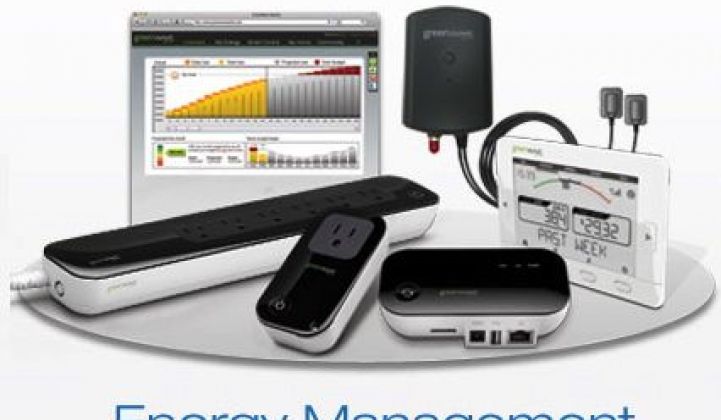In the United States, “connected home” services like home automation, security and entertainment have largely been the purview of cable, telecommunications and home security providers. But in Europe’s deregulated energy markets, they’re increasingly seen as tools for retail utilities to capture and retain customers -- as well as to create new customer relationships and revenue streams to adapt to the changing energy landscape.
After years of pilot tests and targeted rollouts of these smart home services, Europe’s utilities are starting to go big into this still-nascent market. To get there, they’ll need to combine enterprise-scale support for the machine-to-machine networks these deployments represent with a customer experience that can get people outside of the “early adopter” tech crowd to join in.
That’s what GreenWave Reality is hoping to accomplish with big European utility E.ON. On Monday, the Irvine, Calif.-based startup announced that E.ON has picked its technology for a Europe-wide rollout of its Smart Home platform, set to begin in the first half of 2014.
E.ON plans to deliver home automation, networked lighting, customer energy management and rooftop solar monitoring via GreenWave’s Home2Cloud platform, CEO Greg Memo said in a phone interview. Over the coming months, the two plan to develop and test a set of commercially available, off-the-shelf products, and to start marketing the Smart Home service via E.ON’s regional retail utility businesses.
GreenWave, founded in 2008, has raised $31 million from VC investors Craton Equity Partners and The Westly Group, and has been piloting its home energy management platform and interface since 2010. It’s one of a number of startups including iControl, Alarm.com, MiOS and others that are competing to provide the underlying technology to companies eager to colonize the connected home market.
E.ON isn’t the first European utility that GreenWave has helped connect to customers -- similar partnerships with Seas-NVE in Denmark, Nuon in the Netherlands, and Fortum in Sweden are connecting home energy monitors and networked lighting systems. But E.ON, with about 32 million retail customers across the U.K., Germany, Scandinavia and other deregulated European markets, represents a much larger potential customer base. GreenWave has been testing its platform with E.ON in a 75-home U.K. pilot project for the past two years, and was chosen from three other competing vendors for the utility’s broader rollout, he said.
While Memo wouldn't provide specifics on which home device vendors GreenWave would be supporting as part of E.ON’s new service, it’s likely that connected lighting will be one of the first applications. GreenWave is already serving as the platform for commercially available networked lighting systems, such as Technical Consumer Products’ recently launched Connected by TCP LED lighting kit, for example.
E.ON and GreenWave are also working on networked home heating systems, which represent a significant portion of European home energy usage, he said. While the two haven’t specifically named smart thermostats as a connected device they’ll be supporting, thermostats were included in the partners’ U.K. pilot project, indicating a role for them as well.
Solar monitoring is another service on the menu, he said. “We’ll be allowing consumers to understand how much energy they’re producing with solar and how much they’re pulling off the grid -- but more importantly, how and when they’re using energy,” to allow solar-equipped homeowners insight into the relationship between self-generated energy and grid energy in terms of the price they’re paying for using home appliances at different times of the day.
“This is where you start to get into the smart analytics, and you want to have cloud-based applications to look at a lot of different types of tariff rates,” he noted. Third-party solar providers like SolarCity and home security and automation vendors like Alarm.com and Vivint are making moves to connect home energy management and rooftop solar monitoring in the United States -- and solar-rich European markets like Germany are sure to be hot spots for this kind of integration as well.
Finally, Memo described a broad set of potential future services that E.ON is interested in supporting, along the lines of the home automation and networked entertainment services being made available by broadband service providers in the United States.
“The interesting thing about E.ON is that they realize, through deregulation, they’re in the relationship business, they’re in the customer loyalty business,” he said. “They have a strong desire to continue to enhance the comfort in homes and do more home automation.”
GreenWave makes a point of noting that its platform has been built with self-healing, traffic prioritization and other quality-of-service factors that can allow it to support streaming video and other high-bandwidth services, as well as energy data management. In fact, the company says that it’s serving as the behind-the-scenes platform in a million homes, with partners including some as-yet-unnamed home automation service providers, he said.
GreenWave will be demonstrating some of its solutions at the Consumer Electronics Show in Las Vegas this week, a showcase of smart appliances, connected thermostats, energy management devices and other energy-related home automation gear. To date, the utility industry’s participation in the broader world of home automation has been relatively lackluster, with consumers apparently far less interested in tracking their energy use than in keeping their homes secure, networking their entertainment systems, and other such services.
But GTM Research predicts that the home energy management system market will grow from $1.3 billion last year to nearly $4 billion, driven largely by non-utility subscription services, smart thermostats and appliances and off-the-shelf home networking hardware. Telecommunications companies are expected to drive this growth, but there are certainly opportunities for deregulated utilities to join in -- particularly in European markets, such as Germany, where traditional business models are under threat from the disruptions posed by customer-owned renewable energy.



